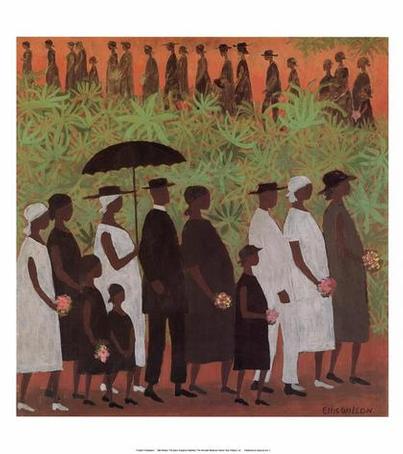[ad_1]

Price $45
Funeral Procession
by Ellis Wilson
Lithograph, Open Edition,
Size 23.5″h x 25″w Approx
In a review of an exhibit of Ellis Wilson’s Haitian paintings, the New York Times noted: “His intense colors and simple outlines invest his figures with almost heroic proportions and great simple dignity.”
Offered at $45
Funeral Procession is Wilson’s best-known painting, thanks to its appearance in the plot of an episode of The Cosby Show in 1985, during the second season of the long-running series. In the program, Mrs. Huxtable acquires the painting—which is ostensibly by her “great-uncle Ellis”—at auction, paying $11,500. At the end of the episode, Dr. Huxtable hung the painting over the living-room mantel, where it would stay for the duration of the series.
In real life, the most Ellis ever got for a painting was about $300. But the Cosby mention did spark a revival of interest in the artist, who had died in obscurity eight years earlier.
Ellis Wilson’s Funeral Procession
In Ellis Wilson’s Funeral Procession, all shots from the seven seasons of The Cosby Show that include the painting Funeral Procession have been edited together, shifting the focus from episodic plot structure to the painter Ellis Wilson’s role in the series level narrative of The Cosby Show.
Ellis Wilson became widely recognized when Funeral Procession, a work he created in Haiti, was hung in the living room of The Cosby Show set in 1986. But Wilson, who received high accolades as a young artist but died relatively unknown in 1977, never lived to see this success.
The Cosby Show was an American television show that drew millions of viewers in an era when television programs played on a television one night a week at a given time. Multicamera standard definition sitcoms shot in front of an audience relied more on performance and dialogue to tell story than aesthetics or nuances of the set. But The Cosby Show used original artwork to connect the television family to the black diaspora. Funeral Procession played a dominant role in the visual representation of the values and the success of the show.
Wilson’s professional life was bracketed by his entrance to the School of the Art Institute of Chicago, which was delayed by the 1919 Chicago Race Riot, and by the series finale of The Cosby Show, which aired on the second night of the 1992 Los Angeles Riots.
[ad_2]
Source link

